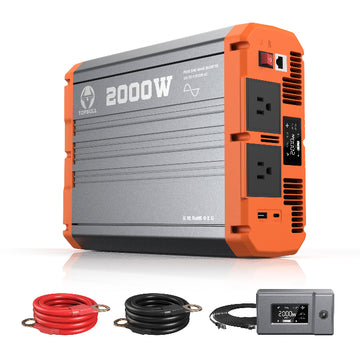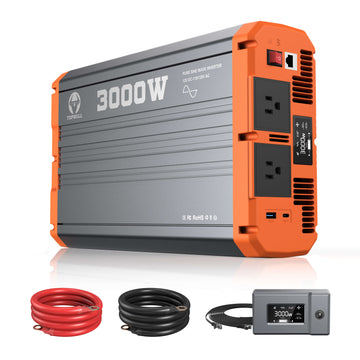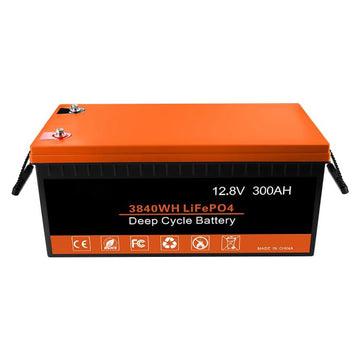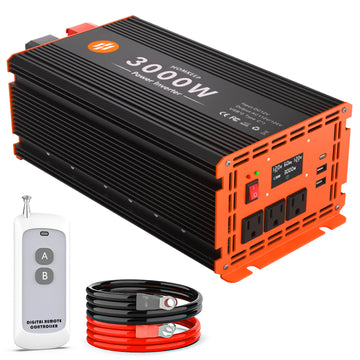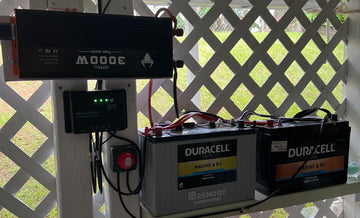Table of contents:
- Is it true you can get free solar panels
- How to get free or low-cost solar panels from the federal government
- Why the government launched the solar incentive programme
- How to Learn About the Latest U.S. Government Solar Incentives
- How to Apply for Free Solar Panels from States
- Summary
- Frequently Asked Questions
Have you heard of solar companies that claim to offer free solar panels funded by the government? Take this with a grain of salt, as these claims are often misleading. In reality, the U.S. federal government does not offer free solar panels. However, some solar companies may advertise this to entice you to sign a solar lease agreement or power purchase agreement (PPA). In this case, while you may be able to enjoy solar power, you don't actually own the panels.
However, amidst all the "free solar panels" misinformation, there are also niche government programmes that actually do provide solar systems to low-income households for free or at low cost.
This guide will walk you through what solar incentive programmes are available from the US government and how to get free solar panels from the government.
Is it true you can get free solar panels
Before exploring how to get free solar panels from the government, it is important to clear up a common misconception: in reality, the government does not directly provide "completely free" solar panels to residents or businesses. What is commonly referred to as "free solar" or "no-cost solar" is the use of specific financial mechanisms or policy incentives that allow end-users to install solar systems with no or minimal initial costs.
What "Free" Solar Really Means
Solar Lease and Power Purchase Agreements (PPAs)
The most common "free" solar model is achieved through a lease or power purchase agreement. Under these agreements, customers allow a third party, such as a solar installer, to install a solar system on their roof and pay for electricity at a rate that is below or comparable to the market price of electricity, without incurring the purchase cost of the solar system. However, the customer does not own the system and is not eligible for tax credits or other government incentives for solar systems.
Zero Down Loan
Another way to get a solar system for close to "free" is to take out a zero down loan. Although the customer will eventually have to repay the loan, the initial investment is zero and the loan can be repaid through savings on electricity bills and government subsidies.
Government Incentives and Subsidies
Governments offer incentives and rebates to promote solar adoption. These incentives can significantly reduce or eliminate the cost of installing solar panels. Federal tax credits, state rebates, and local incentives are common ways to offset costs.
How to get free or low-cost solar panels from the federal government
While the federal government does not directly provide "free" solar panels, it does support the development of solar energy projects through a variety of means, including the Investment Tax Credit (ITC), the Production Tax Credit, and the Federal Loan Guarantee Programme. Individuals and businesses can use these policies to reduce the cost of installing a solar energy system.
Tax credits and investment tax credits
The federal government may offer tax credits or investment tax credits to encourage residents and businesses to install solar energy systems. These credits can indirectly reduce the cost of solar panels by directly reducing the amount of your tax bill.
Solar Investment Tax Credit (ITC)
The Solar Investment Tax Credit is an incentive offered by the U.S. federal government that allows you to receive a percentage of your tax credit for the purchase and installation of a solar energy system. While this is not a direct "free" solar panel, it can significantly reduce your initial investment cost.
Federal loan guarantees and subsidies
The federal government may offer loan guarantees or subsidies for solar projects, which can help reduce the difficulty and cost of obtaining a loan from a bank or other financial institution. Although you'll need to repay the loan, the loan terms may be more favourable, which indirectly reduces the cost of the solar panels.
State and local government incentives
Although not directly from the federal government, many state and local governments also offer solar incentives such as tax credits, rebates, and low-interest loans. These incentives can be stacked with federal government incentives to further reduce the cost of solar panels.
Net Metering
Net metering policies allow you to sell excess electricity generated by your solar panels back to the grid, thus providing a credit towards your utility bill. This helps to further offset the cost of your energy consumption.
It's important to note that while there are various government incentives that can be used to reduce the cost of solar panels or provide financial support, they are not the same as getting solar panels directly from the federal government "absolutely free". All of these incentives involve different criteria and paperwork, so it is important to do your research to ensure that you qualify for the programme and understand the application process.
Why the government launched the solar incentive programme
There are several important purposes for the government to launch a solar incentive programme. Firstly, promoting renewable energy is one of the key measures to combat climate change and reduce greenhouse gas emissions. By promoting solar energy, the government hopes to reduce its dependence on fossil fuels and thus slow down the process of global warming. Secondly, these incentives aim to promote the innovation and development of green technologies and encourage enterprises to invest in solar energy-related technologies to enhance overall energy efficiency.
In addition, the solar energy incentive programmes also help create job opportunities, particularly in the manufacturing, installation and maintenance of the renewable energy industry. As the solar energy industry expands, the demand for related jobs will increase, thereby boosting economic growth and social development. At the same time, by providing economic incentives such as tax breaks and subsidies, governments reduce the cost of installing solar equipment for consumers, motivating more households and businesses to switch to solar energy use.
Finally, solar incentive programmes also greatly enhance the country's energy security by increasing the diversity of energy supplies in order to reduce dependence on external energy resources, thereby increasing economic resilience and stability. Taken together, these measures not only help to protect the environment, but are also an important means of promoting sustainable economic and social development.
How to Learn About the Latest U.S. Government Solar Incentives
To learn about the latest U.S. government solar incentives, there are several steps you can take to ensure you get the most accurate and up-to-date information:
Visit the official U.S. government website
Visit the websites of official agencies such as the U.S. Department of Energy (DOE) or the U.S. Department of the Treasury , which typically publish information on incentives and subsidies related to solar and other renewable energy sources.
One of the most comprehensive and up-to-date sources is the Database of State Incentives for Renewables & Efficiency (DESIRE), which provides a comprehensive list of solar incentives and policies by state. Not only is it regularly updated with information, but it also provides detailed guidance on each policy and incentive.
Focus on solar tax credits and production tax credits
The Investment Tax Credit (ITC) is one of the main incentives offered by the U.S. government to encourage the development of renewable energy sources such as solar. Learn about the current ITC credit rates and eligibility requirements, which can help you calculate the potential savings of installing a solar energy system.
The Production Tax Credit (PTC) is a tax credit given for electricity generated by renewable energy projects, and while this is more geared towards large commercial projects, knowing this information can also help provide a comprehensive understanding of the market.
Research state and local solar incentives
State and local governments in the U.S. also have their own solar incentives, including direct subsidies, low-interest loans, property tax breaks and more. Learn about the policies in your state or region, as they may complement federal policies and work together to lower your installation costs.
Subscribe to energy and environmental related newsletters
Follow newsletters or blogs in the energy, environmental, and renewable energy fields, as these outlets are often up-to-date on the latest policy developments and market trends.
Consult a professional advisor
Consider consulting a solar installer or a professional energy consultant, who often has in-depth knowledge of current incentives and market dynamics and can provide you with personalised advice and assistance.
How to Apply for Free Solar Panels from States
Applying for free or low-cost solar panels from U.S. states isn't a process that goes directly through the state government, as states don't usually offer free solar panels directly. However, there are ways and strategies that can help you reduce costs or take advantage of incentives to get a solar panel system.By the end of 2032, the federal solar investment tax credit will be 30 percent, which is a good start to lowering the cost of your solar system.
You can also get additional solar incentives from your state, municipality, or utility company that can further reduce the cost of going solar. Every penny reduced from your solar costs is a penny saved in energy costs.
A team of solar experts reviewed solar incentives in all 50 states to determine which states are the most solar friendly. Here are the more solar-friendly states for solar rebates and incentives:
California:
California has strong solar incentives, including tax credits and net metering policies. A number of nonprofits and companies offer free or low-cost solar installations, especially programs for low-income households.
Texas:
While Texas has relatively few subsidies, some companies offer leases or PPAs with no initial cost, enabling residents to go solar without paying upfront costs.
Florida:
Some local governments and energy companies offer incentives to help residents obtain solar panels at low cost or through PPAs.
Arizona:
Arizona has a strong solar market, and some companies offer financing options that allow residents to install solar equipment without upfront costs.
New York State:
New York State's Solar Incentive Program and other financial incentives make it more feasible to install solar panels through leasing or community solar projects.
Maryland and New Jersey:
These states have aggressive renewable energy policies that support low-cost installation of solar systems by residents. Some also offer low-cost financing options.
View solar incentives by state
Summary
By understanding and taking full advantage of the solar incentives offered by the government and the various low-cost ways to go solar, you can easily make a green energy transition for your home or business. While "free" solar panels are not completely cost-free, with proper planning and selection, you can minimise the cost of installation and enjoy the long-term economic and environmental benefits of solar energy.
Frequently Asked Questions
Does the U.S. government pay for solar panels?
The U.S. government does not directly pay for solar panels, but supports the development of solar energy projects through tax credits, loan guarantees, and other means to reduce the cost of installation.
How do I qualify for free solar panels?
Qualifying for free or low-cost solar panels usually depends on the specific requirements of government incentives and your personal or business situation. You need to understand the relevant policies in detail and prepare the appropriate application materials.
Are free solar panel programmes legal?
Free or low-cost solar panel schemes launched by the government or formal organisations are legal. However, please note that there may also be false promotions or scams in the market, so be sure to choose carefully.

